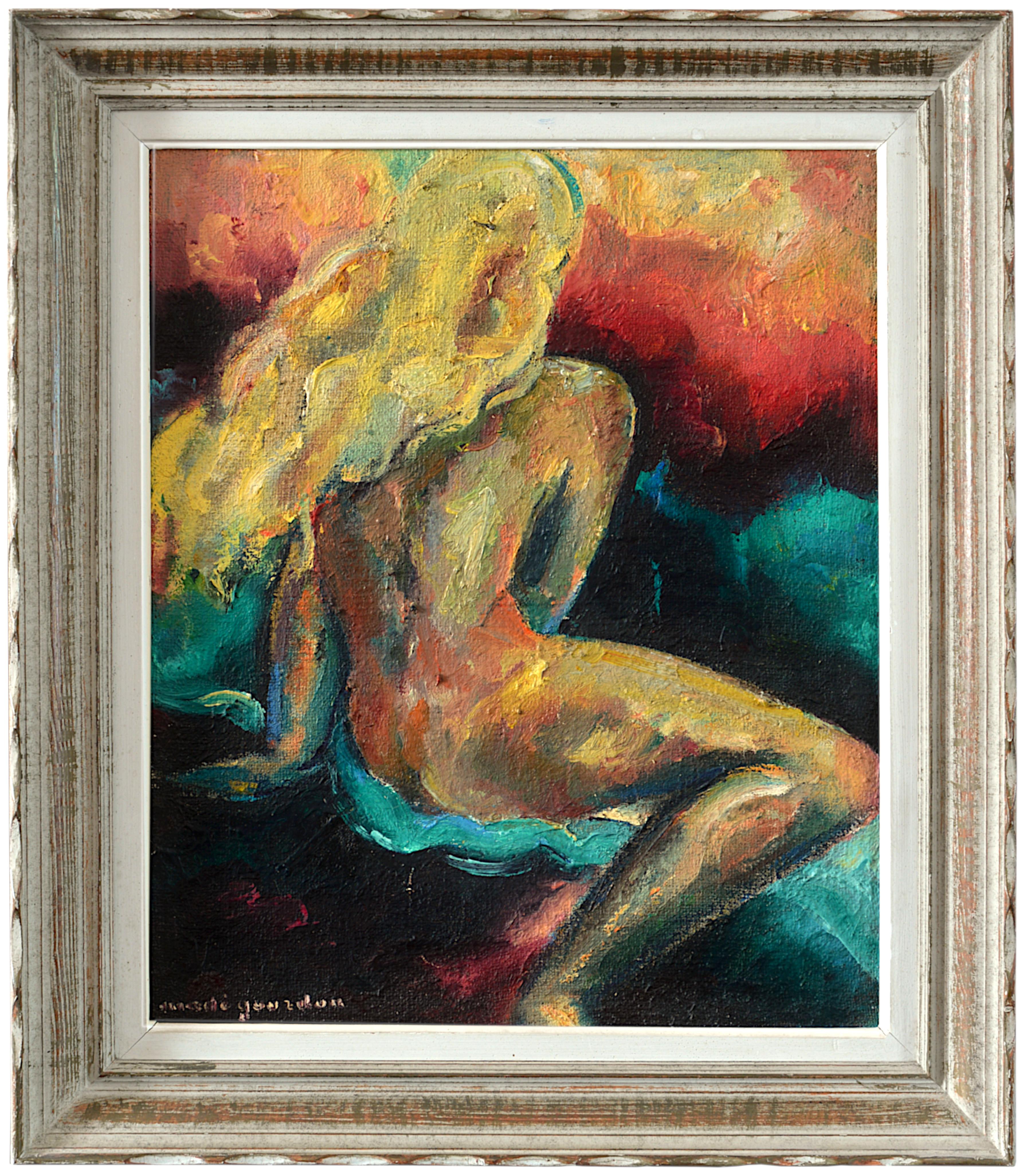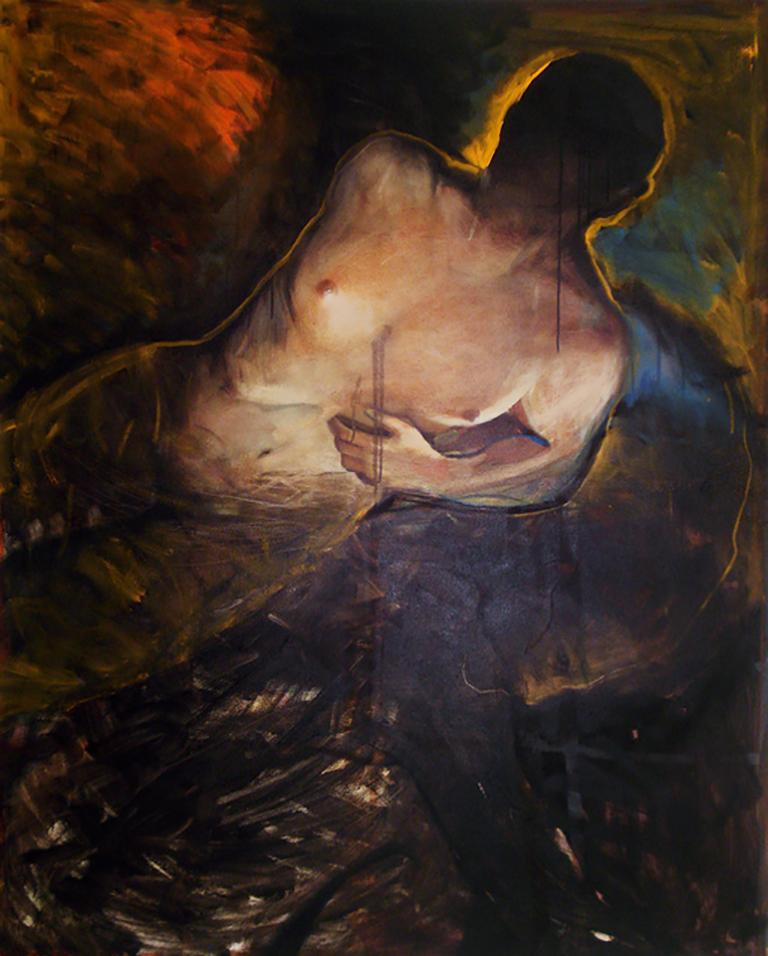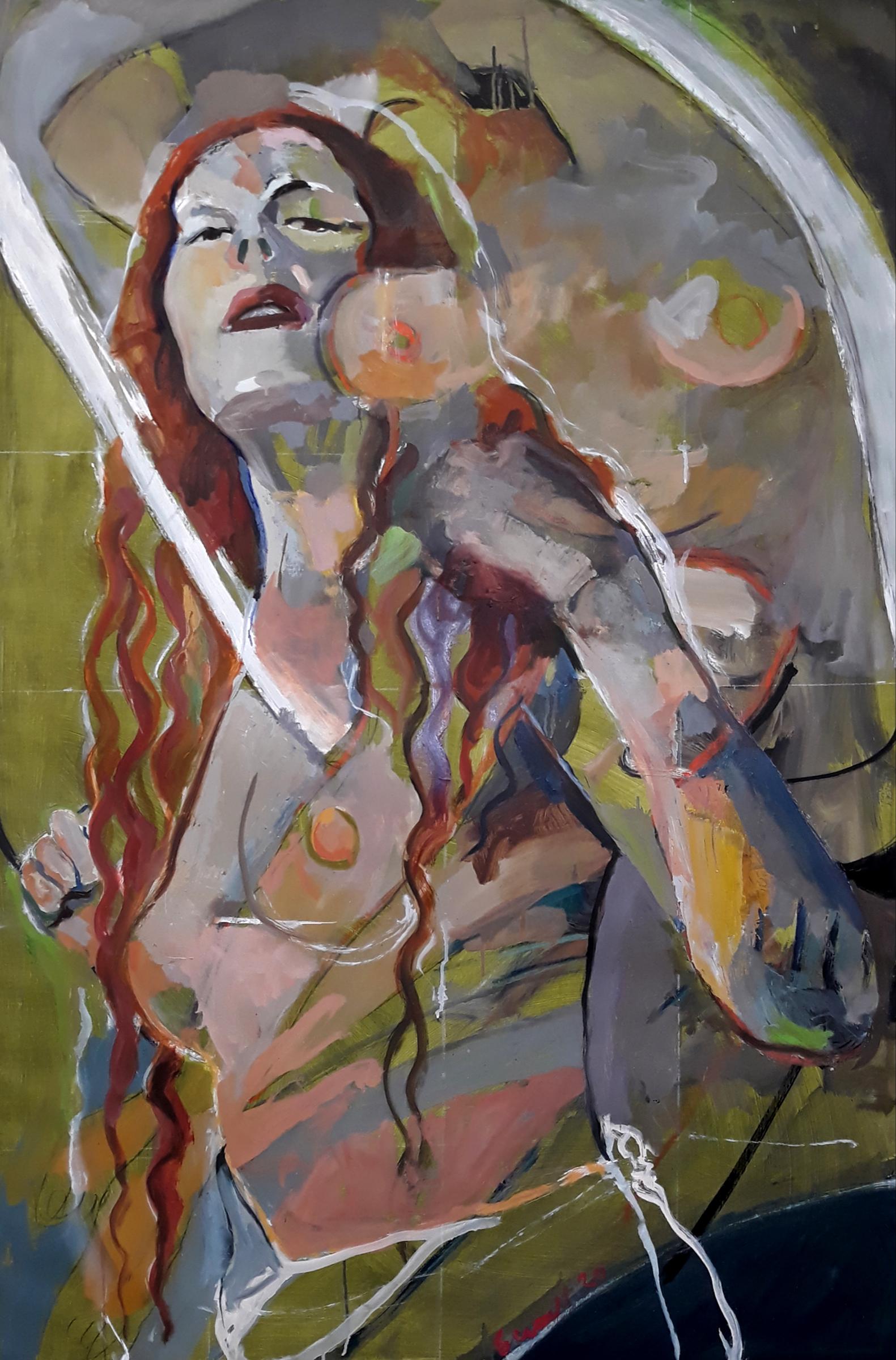Items Similar to Edouard Goerg, Les 3 Brunes, Large Oil on Canvas, 1955
Want more images or videos?
Request additional images or videos from the seller
1 of 11
Edouard GoergEdouard Goerg, Les 3 Brunes, Large Oil on Canvas, 19551955
1955
About the Item
Large oil on canvas by Edouard GOERG (1893-1969), France, 1955. LES 3 BRUNES. With frame : 114x95cm - 44.9x37.4 inches ; without frame : 92.2x73 cm - 36.3x28.75 inches. Format 30F. Signed "E.Goerg" (see photo). On the back, inscription by the hand of the painter "Les 3 brunes E. Goerg mai-Juin 1955". One of his masterpieces in theme and format! Edouard Goerg possessed an immediately identifiable and particularly poetic style, which made him one of the most sought-after French painters of his time. One could draw many comparisons between her life and that of Chagall, both marked by the death of adored wives, and by the emergence of the work that followed. On this subject, art critics comparing the work of the two painters wondered which of the two was at the origin of the flowery themes developed, on the one hand, by Edouard Goerg through his flower-women and, on the other hand, by Marc Chagall in the continuation of his work. hus Goerg developed a dreamlike imagination highly prized by collectors, where women and flowers would become inseparable.
Édouard Goerg is one of the major artists of his generation. Coming from a Champagne family, he was born in Sidney, Australia, in 1893, during a professional stay of his father. After passing through London, he arrives in Paris at the age of seven. At twenty, between 1913 and 1914, he studieds painting at the Académie Ranson with Maurice Denis and Paul Sérusier. He travels to Italy and India. Mobilized in 1914, he is sent to Artois, then to Argonne. From 1920, he exhibits at the Salon des Independants, then at the Salon d'Automne where he joins with Laboureur. At Berthe Weil, in 1924, he participates in the exhibitions of the Gromaire group, a prelude to a series of exhibitions in Paris (Berthe Weill, Bernheim Jeune), as in Brussels (Le Centaure). Goerg illustrates books including Table of the beyond by F.Boutet. In 1928, he meets Paul Guillaume who exhibits his works in Boston and the Art Institute of Chicago. He continues to show his works, satires of the bourgeois manners, at Bernheim Jeune, then at Lucie Krogh. In 1934, he travels to Belgium and Holland where he paints surrealist paintings that will be exhibited at Jeanne Castel. In 1935-1936, he meets Aragon, who opened the doors of the houses of the cultures created by the Association of Writers and Revolutionary Artists. The Spanish war and the Second World War mark it deeply. He must protect his daughter and his Jewish women against the pursuit of the Nazis. The latter will die by lack of care. In 1949, Goerg is appointed professor of Fine Arts and teaches at the Grande Chaumière. He is elected to the Academy of Fine Arts in 1965. He dies in 1969.
" His satirical verve is that of a Toulouse-Lautrec of the Roaring Twenties. Goerg instigates the world from which he comes, his ceremonial, morgue and the falsity of important people " (Michel Charzat, La jeune peinture française)
In the paintings of his early period he attacks the morality of post-war bourgeois society, and in that sense was similar to expressionist painters like Georg Grosz. The major works of this period are: Pirate (1922); Gourmand (1923); Bar (1923); Marriage (1924); Window (1924); Don Quixote (1925); and Good fortune (1925). He travels extensively, and in 1935 visits the museums of Holland, where he is deeply influenced by the works of Hieronymus Bosch and Bruegel. He then directs a series of paintings on the theme of the tragedy of the human condition, under the generic title: "eThis is how the world turns under the eye of the police".
After the Second World War, he savs his vitriolic commentary for his etchings, and in his paintings ceased to criticize real life and instead celebrated the evil charms of the flower-girls. He illustrates many books, including: Tales of Hoffmann, Picture of the Beyond by Frederick Boutet, Knock by Jules Romains, The Flowers of Evil by Charles Baudelaire, The Book of Job and Apocalypse of St. John by Sir Isaac Newton, who have all demonstrated his engraving skills. Asked about his art, he confesses that he had first wanted to try to unblock the "comedy of everyday forms". Essentially a painter of figures, he generally paints groups of feminine nudes; however, these nudes are often accompanied by conservatively dressed male spectators, who are the most enduring symbol of his first comic intentions. Nevertheless, the comedy is loaded with bitterness and sarcasm.
After several refusals, he is accepted at the Salon des Artistes Indépendants in 1922. His work then appears at the Salon d'Automne, at the Salon des Tuileries, at the Salon des Peintres Témoins of Their Time and at the Salon of the Society of Painters-Engravers, where he becomes honorary president from 1945 to 1958. He makes his first personal exhibition in Paris in 1925. After that, he exhibits regularly in France and abroad. There have been several retrospectives of his work, notably in 1988 at the Grand Palais in Paris and the Salon du Verney in Vichy. In 1949, he receives the very prestigious Hallmark prize for Nativity. In 1950 he receives the Lugano Prize for Engraving.
"In the mid-twenties, he developed his plastic code: canvases with a flat surface, a chromatic range that has brightened with phosphorescent blues and greens, a craft that wants to transcend the subject by intrinsic beauty. Goerg works with the patience of the alchemist his paste that he superimposes to obtain the sumptuousness of enamels. A pictorial magic unifies the different periods of the work" (Michel Charzat, La jeune peinture française)
- Creator:Edouard Goerg (1983-1969, French)
- Creation Year:1955
- Dimensions:Height: 44.89 in (114 cm)Width: 37.41 in (95 cm)Depth: 2.76 in (7 cm)
- Medium:
- Movement & Style:
- Period:
- Condition:
- Gallery Location:Saint Amans des cots, FR
- Reference Number:1stDibs: LU1088213902312
About the Seller
5.0
Vetted Seller
These experienced sellers undergo a comprehensive evaluation by our team of in-house experts.
1stDibs seller since 2018
34 sales on 1stDibs
- ShippingRetrieving quote...Ships From: Saint Amans des cots, France
- Return PolicyA return for this item may be initiated within 2 days of delivery.
More From This SellerView All
- DreamLocated in Saint Amans des cots, FROil on canvas by Madé Gourdon, France, 1960s. "Dream". with frame: 70x61 cm - without frame: 55x46 cm. 10F format. Signed "Madé Gourdon" in the lower left. In its frame Montparnasse....Category
1960s Expressionist Figurative Paintings
MaterialsBurlap, Oil, Canvas
- Nandor Vagh Weinmann, Oil on cardboard, Naked Back, 1930sLocated in Saint Amans des cots, FROil on cardboard by Nandor VAGH WEINMANN (1897-1978), France, 1930s. Naked back. With frame: 64x56 cm - 25.2x22 inches ; without frame: 46x38cm - 18.1x15 inches. 8F format. Signed "Nandor V. Weinmann" lower left. In its Montparnasse frame. Very good condition. Born October 3, 1897 in Budapest, Nándor is the older brother of Elemer and Maurice Vagh-Weinmann. He came to Paris to present his work in 1931. He died on December 12, 1978 near Montereau (Seine-et-Marne) following an automobile accident. He is the most colorful of the three “expressionist” brothers. Painter of figures, landscapes, especially open mountains, and bouquets in bright colors. He is also a religious painter and then finds the tragic condition. Born in BUDAPEST on October 3, 1897, Nandor Vagh Weinmann belongs to a profoundly artistic people. Living in the heart of Central Europe where they came from Asia a millennium ago, the Hungarians have preserved a strong ethnic individuality whose mark is their very synthetic, non-Indo-European language. Resistant to secular invasions, they have kept the virtues of a very ancient humanity that have become rare in our modern world, especially since their way of life has remained essentially rural until today. In the arts they know how to express a generous, extreme sensibility and by the poetic verb, by the musical rhythms and also by a popular art of a richness, an exceptional harmony. Until the age of thirty-four, during the decisive years of childhood and youth, Nandor Vagh Weinmann was intimately imbued with popular life and the soul of Hungary. From the capital where his father was a jeweler and had a family of ten children, Nandor was the fifth, he knew first of all the suburbs, the populated districts, the rigors in winter of the cold and the snow. A very mobile existence made him acquainted with all of Hungary, from the Danube to Transylvania, its infinite plains and its wild mountains, its immense villages with ample low houses, and its towns which are still immense villages. The painter is passionate about rustic works, harvest scenes, beautiful folk costumes. Coming into direct contact with the peasants, he learned to know their soul. These contacts gave the artist a direct feeling for popular life and soul, as Millet once understood the peasants of Barbizon and Normandy whose existence he shared. What fascinated Nandor Vagh Weinmann above all were the festivals which enlivened the dreary life of the countryside, the circuses, the merry-go-rounds, the gypsies unleashing orgies of music, light and color. In the party, and especially the Hungarian party, the whole soul of a people, all its energy, its need for movement, for intensity, is expressed in its pure state and realizes the primary and essential form of what is called beauty. And as if melted at the party, there is the infinite steppe where herds of horses and oxen circulate where terrible storms sometimes roar where the seasons unfold their grandiose splendours. The young Nandor Vagh Weinmann nourishes his sensitivity to his inexhaustible shows, both eternal and always new, a sensitivity which very early declared itself that of a painter. Since the age of fourteen he painted, and since then he never stopped doing it. Two of his brothers Maurice, two years his junior, who had a remarkable career similar to that of Nandor and later Elemer who became Maurice's pupil, also devoted themselves to painting, despite family obstacles. And the three brothers united by a common passion worked together in Hungary and later in France. Painting was so much in the blood of the family, as in the past among the Veroneses, the Breughels, the Lenains, the Van Loos and so many other artistic dynasties, that three sons of the Vagh Weinmanns became painters in their turn. One of these, Emeric, son of Nandor, today occupies an important place in the contemporary school. Nandor, at fifteen, was a pupil of the Academy of Fine Arts in Budapest where he worked diligently, then at that of Vienna. He painted many portraits, but also landscapes, compositions and, by his relentless work, managed to live from his brush, although married very young and having to overcome many hardships. He therefore knew the hardships and miseries of life. These strongly impregnated his vision as an artist and explain the thrill of humanity that runs through all his work. A particularly moving experience was reserved for him at the age of twenty. In the hospitals of Budapest he had to paint extraordinary cases, operations, frightful wounds, the deformations to which our poor body is subjected by traumas and physiological decompositions. In these circumstances, it is not a question of gratuitous art, of formal research but of immediate, authentic expressions of our flesh and our being. We know that Breughel Velázquez and Goya had been haunted by the sight of cripples and of madmen Géricault by that of corpses. But life is ultimately stronger than anything, and it is life that Nandor Vagh Weinmann has passionately observed and translated through all the places where he has always painted on nature. Nothing stopped him. It happened to him to paint, for example in front of the mill of Linselles by a weather so cold, that nobody could stay outside, and that he did not leave the place before having finished his work. Because he works constantly on the ground, under the sky, in the silence he loves. His reputation is established. He exhibited at the national fair in Budapest, in the big cities of Hungary Szeged, Szombathely, Veszprém, Kaposvar. In 1931, like all artists in the world, he came to France. But unlike the others, he did not settle in Paris. Because Nandor Vagh Weinmann does not belong to this group of cosmopolitans that we call the School of Paris. He settled in Toulouse, where he remained for a long time with his brothers, and traveled throughout France, eager for new ties, exhibiting in the most diverse cities, in Bordeaux, Marseille, Lyon, Agen, Bayonne, Dax, Tarbes, Grenoble, Nice, Cannes, Strasbourg, Mulhouse, Colmar, Lille. He even crossed borders. He was in Saint Sebastian, in Geneva, and once in Egypt in 1927 where he painted King Fouad...Category
1930s Expressionist Figurative Paintings
MaterialsOil, Cardboard
- Dominique PERY, Marianne, Oil on canvas 1987Located in Saint Amans des cots, FROil on canvas by Dominique PERY, France, 1987. Nude named "Marianne". 73x60 cm - 28.75x23.6 in. 20F Format. Signed "D.Péry" lower right (see photo). Countersigned twice and dated 198...Category
1980s Neo-Expressionist Figurative Paintings
MaterialsCanvas, Oil
- Oil on canvas, Naked woman lying in front of her mirrorBy Robert Louis Raymond DuflosLocated in Saint Amans des cots, FROil on canvas by Robert Louis Raymond DUFLOS (1898-1929), France, 1920s. Naked woman lying in front of her mirror. With frame: 95x61.5 cm - 37.4x24.2 inches - without frame: 73x40cm ...Category
1920s Art Deco Nude Paintings
MaterialsCanvas, Oil
- R.B. FELTRAP, Oil on canvas, Nude, 1937Located in Saint Amans des cots, FROil on canvas signed R.B.FELTRAP, France, 1937. Nude. With frame : 101.5x82.5 cm - 40x32.5 inches ; without frame : 92x73 cm - 36.2x28.75 inches. Format 30F. Signed and dated "R.B.Fe...Category
1930s Art Deco Figurative Paintings
MaterialsCanvas, Oil
- Fernande Horovitz-Edwards, Bathers, Large Oil on Canvas, 1930sLocated in Saint Amans des cots, FRLarge oil on canvas by Fernande Horovitz-Edwards, France, 1930s. "Bathers". With frame: 117,5x90x4 cm - 46.3x35.4x1.6 inches. Without frame: 114x87 cm - 44.9x34.25 inches. Signed low...Category
1930s Post-Impressionist Figurative Paintings
MaterialsCanvas, Oil
You May Also Like
- In The Room #4 by Katya Tsareva - Expressionist painting, oil on canvas, 2021Located in Basel, BSThe Room #4 is the 4th work in "In The Room" series by contemporary artist Katya Tsareva. In this series the artist continues to analyze the difficult re...Category
2010s Expressionist Nude Paintings
MaterialsOil, Canvas
- Seated NudeBy Helge HelmeLocated in New York, NYAxel Henry Helge Helme (1894 Roskilde, Denmark 1987), Seated Nude, circa 1930, oil on canvas, original frame Son of a merchant, Helge Helme was admitted ...Category
20th Century Expressionist Nude Paintings
MaterialsOil, Canvas
- "Aquarius" Oil Painting 31.5" x 51" inch by Sergey DolmatovLocated in Culver City, CA"Aquarius" Oil Painting 31.5" x 51" inch by Sergey Dolmatov Year: 2014Category
21st Century and Contemporary Expressionist Figurative Paintings
MaterialsCanvas, Oil
- After Icarus, ghostly floating figure, black w orange, blue nudeBy Audrey AnastasiLocated in Brooklyn, NYOil on canvas ABOUT the artist: Audrey Frank Anastasi is a prolific feminist artist, working in painting, drawing, collage, mixed media, & printmaking. She is also curator, gallerist, educator and arts advocate. Most of Ms. Anastasi's figurative works are painted with her non-dominant left hand. She has created large bodies of works of birds, animals and birch trees. She has had 20 solo & 200 group shows. Her "ref-u-gee" series will be shown in 2020 at Medgar Evers College in collaboration with the Valentine Museum of Art, Brooklyn. Accompanying the show will be a limited-edition monograph w/ over 180 images and a foreword by Phyllis Braff. Ms. Anastasi's collage series was exhibited at Welancora Gallery, Brooklyn, in May, 2019. In 2018, ten paintings were exhibited in "Painting to Survive," curated by Yale critic Jonathan Weinberg. Book and catalog publications include "Stations of the Cross", SPQR press, BREUCKELEN magazine, “Audrey Frank Anastasi”, catalog essay Cindy Nemser, and "Collage," essay by Giancarlo T. Roma. Public art includes a portrait of Jo Davidson...Category
2010s Expressionist Figurative Paintings
MaterialsOil, Canvas
- Red Ophelia, colorful abstract female nudeBy Tom BennettLocated in Brooklyn, NYAn expressionist figurative oil painting integrating abstracted form and color. The title suggests the classic Shakespearean character from Hamlet and the symbolism of beauty, madnes...Category
2010s Expressionist Figurative Paintings
MaterialsCanvas, Oil
- Unfinished Thought, female nude, abstracted figurative painting earth tonesBy Tom BennettLocated in Brooklyn, NYExpressionist, abstracted figurative female nude About Tom Bennett: With quick brushstrokes, Tom Bennett creates representational images of human figures and animals, emphasizing mo...Category
21st Century and Contemporary Expressionist Figurative Paintings
MaterialsCanvas, Oil



